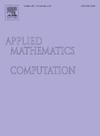Linear and nonlinear filtering for a two-layer quasi-geostrophic ocean model
IF 3.4
2区 数学
Q1 MATHEMATICS, APPLIED
引用次数: 0
Abstract
Although the two-layer quasi-geostrophic equations (2QGE) are a simplified model for the dynamics of a stratified, wind-driven ocean, their numerical simulation is still plagued by the need for high resolution to capture the full spectrum of turbulent scales. Since such high resolution would lead to unreasonable computational times, it is typical to resort to coarse low-resolution meshes combined with the so-called eddy viscosity parameterization to account for the diffusion mechanisms that are not captured due to mesh under-resolution. We propose to enable the use of further coarsened meshes by adding a (linear or nonlinear) differential low-pass filter to the 2QGE, without changing the eddy viscosity coefficient. While the linear filter introduces constant (additional) artificial viscosity everywhere in the domain, the nonlinear filter relies on an indicator function to determine where and how much artificial viscosity is needed. Through several numerical results for a double-gyre wind forcing benchmark, we show that with the nonlinear filter we obtain accurate results with very coarse meshes, thereby drastically reducing the computational time (speed up ranging from 30 to 300).
双层准地养海洋模型的线性和非线性滤波
尽管两层准地转方程(2QGE)是一个简化的分层风动海洋动力学模型,但其数值模拟仍然受到需要高分辨率以捕捉全部湍流尺度谱的困扰。由于这种高分辨率会导致不合理的计算时间,因此通常采用粗糙的低分辨率网格并结合所谓的涡粘参数化来解释由于网格分辨率不足而无法捕捉到的扩散机制。我们建议通过在 2QGE 中添加(线性或非线性)微分低通滤波器,在不改变涡粘系数的情况下使用进一步粗化的网格。线性滤波器在域内各处引入恒定(额外)的人工粘性,而非线性滤波器则依赖于一个指示函数来确定在何处以及需要多少人工粘性。通过几个双褶皱风力强迫基准的数值结果,我们表明,使用非线性滤波器,我们可以用非常粗的网格获得精确的结果,从而大大缩短计算时间(加速度从 30 到 300 不等)。
本文章由计算机程序翻译,如有差异,请以英文原文为准。
求助全文
约1分钟内获得全文
求助全文
来源期刊
CiteScore
7.90
自引率
10.00%
发文量
755
审稿时长
36 days
期刊介绍:
Applied Mathematics and Computation addresses work at the interface between applied mathematics, numerical computation, and applications of systems – oriented ideas to the physical, biological, social, and behavioral sciences, and emphasizes papers of a computational nature focusing on new algorithms, their analysis and numerical results.
In addition to presenting research papers, Applied Mathematics and Computation publishes review articles and single–topics issues.

 求助内容:
求助内容: 应助结果提醒方式:
应助结果提醒方式:


